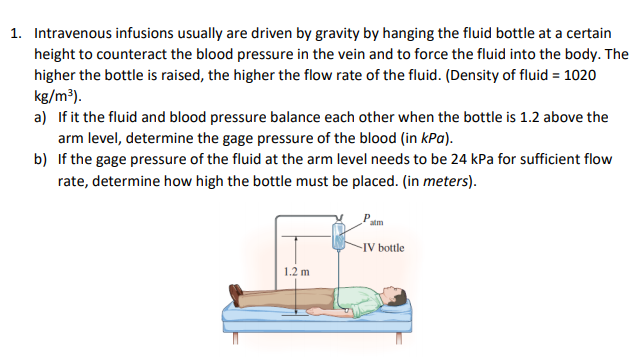1. Intravenous infusions usually are driven by gravity by hanging the fluid bottle at a certain height to counteract the blood pressure in the vein and to force the fluid into the body. The higher the bottle is raised, the higher the flow rate of the fluid. (Density of fluid = 1020 kg/m³). a) If it the fluid and blood pressure balance each other when the bottle is 1.2 above the arm level, determine the gage pressure of the blood (in kPa). b) If the gage pressure of the fluid at the arm level needs to be 24 kPa for sufficient flow rate, determine how high the bottle must be placed. (in meters). atm -IV bottle 1.2 m
1. Intravenous infusions usually are driven by gravity by hanging the fluid bottle at a certain height to counteract the blood pressure in the vein and to force the fluid into the body. The higher the bottle is raised, the higher the flow rate of the fluid. (Density of fluid = 1020 kg/m³). a) If it the fluid and blood pressure balance each other when the bottle is 1.2 above the arm level, determine the gage pressure of the blood (in kPa). b) If the gage pressure of the fluid at the arm level needs to be 24 kPa for sufficient flow rate, determine how high the bottle must be placed. (in meters). atm -IV bottle 1.2 m
International Edition---engineering Mechanics: Statics, 4th Edition
4th Edition
ISBN:9781305501607
Author:Andrew Pytel And Jaan Kiusalaas
Publisher:Andrew Pytel And Jaan Kiusalaas
Chapter7: Dry Friction
Section: Chapter Questions
Problem 7.35P: The weight of the cylindrical tank is negligible in comparison to the weight of water it contains...
Related questions
Question
Final answer in 4 decimal places

Transcribed Image Text:1. Intravenous infusions usually are driven by gravity by hanging the fluid bottle at a certain
height to counteract the blood pressure in the vein and to force the fluid into the body. The
higher the bottle is raised, the higher the flow rate of the fluid. (Density of fluid = 1020
kg/m³).
a) If it the fluid and blood pressure balance each other when the bottle is 1.2 above the
arm level, determine the gage pressure of the blood (in kPa).
b) If the gage pressure of the fluid at the arm level needs to be 24 kPa for sufficient flow
rate, determine how high the bottle must be placed. (in meters).
atm
-IV bottle
1.2 m
Expert Solution
This question has been solved!
Explore an expertly crafted, step-by-step solution for a thorough understanding of key concepts.
This is a popular solution!
Trending now
This is a popular solution!
Step by step
Solved in 3 steps with 5 images

Knowledge Booster
Learn more about
Need a deep-dive on the concept behind this application? Look no further. Learn more about this topic, mechanical-engineering and related others by exploring similar questions and additional content below.Recommended textbooks for you

International Edition---engineering Mechanics: St…
Mechanical Engineering
ISBN:
9781305501607
Author:
Andrew Pytel And Jaan Kiusalaas
Publisher:
CENGAGE L

International Edition---engineering Mechanics: St…
Mechanical Engineering
ISBN:
9781305501607
Author:
Andrew Pytel And Jaan Kiusalaas
Publisher:
CENGAGE L